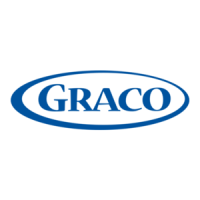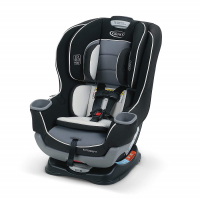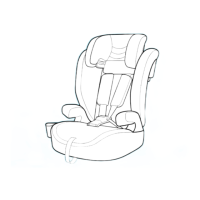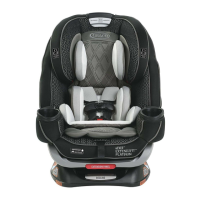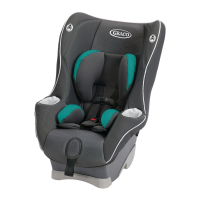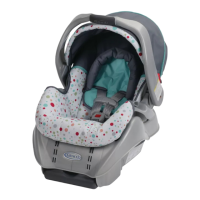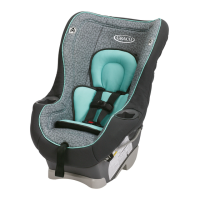3 4 5
If you need help. Please contact our Customer Service
Department with any questions you may have concerning
parts, use, or maintenance. When you contact us, please
have your product’s model number and manufactured
in (date) ready so that we may help you eciently. The
numbers can be found on a sticker on the underside of your
child restraint.
UK & Ireland
Graco Children’s Products
Halifax Avenue
Fradley Park
Licheld WS13 8SS
United Kingdom
Newell Rubbermaid A/S
Stamholmen 157
3.sal DK-2650 Hvidovre
Konsumentkontakt
RUBBERMAID FRANCE SAS
18 AVENUE DU GUIMAND
26120 MALISSARD
FRANCE
WARNINGS to parents and other users.
Failure to properly use this child restraint increases the risk of
serious injury or death in a sharp turn, sudden stop or crash.
Your child’s safety depends on you installing and using this
child restraint correctly. Use ONLY forward facing.
Even if using this child restraint seems easy to gure out on
your own, it is very important to READ, UNDERSTAND AND
FOLLOW THE OWNER’S MANUAL.
The manual should be stored in the slot below the recline
lever. You must also read your vehicle owner’s manual.
Your child’s safety depends on:
1. Inserting the harness straps in the proper slots for
your child.
2. Properly securing your child in the child restraint.
3. Selecting a suitable location for the child restraint in
your vehicle.
4. Properly routing and securing the vehicle seat belt.
IMPORTANT WARNING
1. This is a “Universal” child restraint. It is approved to Regu-
lation No. 44, 04 series of amendments, for general use in
vehicles and it will t most, but not all, car seats.
2. A correct t is likely if the vehicle manufacturer has
declared in the vehicle handbook that the vehicle is
capable of accepting a “Universal” child restraint for this
age group.
3. This child restraint has been classied as “Universal” under
more stringent conditions than those which applied to
earlier designs which do not carry this notice.
4. If in doubt, consult either the child restraint manufacturer
or the retailer.
5. Only suitable if the approved vehicles are tted with 3
point/static/with retractor safetybelts, approved to UN/
ECE Regulation No. 16 or other equivalent standards.
IMPORTANT PLEASE READ
• DO NOT INSTALL OR USE THIS CHILD RESTRAINT
UNTIL YOU READ AND UNDERSTAND THE INSTRUC-
TIONS IN THIS MANUAL AND IN YOUR VEHICLE
OWNER’S MANUAL. DO NOT let others install or use the
child restraint unless they understand how to use it.
• FAILURE TO PROPERLY USE THIS CHILD RESTRAINT
INCREASES THE RISK OF SERIOUS INJURY OR DEATH
IN A SHARP TURN, SUDDEN STOP OR CRASH. Your
child can be injured in a vehicle even if you are not in a
crash. Sudden braking and sharp turns can injure your
child if the child restraint is not properly installed or if
your child is not properly secured in the child restraint.
• PLACE THIS CHILD RESTRAINT IN A FORWARD FAC-
ING POSITION ONLY.
• NEVER PLACE THIS CHILD RESTRAINT IN A VEHICLE
SEATING LOCATION THAT HAS A FRONT AIR BAG. If
an air bag inates, it can hit the child and child restraint
with great force and cause serious injury or death to your
child. Refer to your vehicle owner’s manual for informa-
tion about side air bags and child restraint installation.
• According to accident statistics, CHILDREN ARE SAFER
WHEN PROPERLY RESTRAINED IN REAR VEHICLE
SEATING POSITIONS RATHER THAN FRONT SEATING
POSITIONS. For a vehicle with a front passenger air bag,
refer to your vehicle owner’s manual as well as these
instructions for child restraint installation.
• NEVER LEAVE YOUR CHILD UNATTENDED.
• NEVER LEAVE A CHILD RESTRAINT UNSECURED IN
YOUR VEHICLE. An unsecured child restraint can be
thrown around and may injure occupants in a sharp turn,
sudden stop or crash. Remove it or make sure that it is
securely belted in the vehicle.
• It is recommended that any luggage or other objects
liable to cause injuries in the event of a collision shall be
properly secured.
• REPLACE THE CHILD RESTRAINT AFTER AN ACCIDENT
OF ANY KIND.
An accident can cause damage to the child restraint that
you cannot see.
• DO NOT MODIFY YOUR CHILD RESTRAINT or use any
accessories or parts supplied by other manufacturers.
• NEVER USE CHILD RESTRAINT IF IT HAS DAMAGED
OR MISSING PARTS. DO NOT use a cut, frayed or dam-
aged child restraint harness or vehicle seat belt.
• THE HARNESS COVERS ARE IMPORTANT for the safety
of your child, therefore use them at all times.
DO NOT use another manufacturers seat cover with this
child restraint. See your retailer for Graco replacement
parts only.
DO NOT USE in any conguration not shown in the
instructions.
DO NOT MODIFY YOUR child restraint or use any
accessories or parts supplied by other manufacturers.
• THE RIGID ITEMS AND PLASTIC PARTS of this child
restraint must be so located and installed that they are
not liable, during everyday use of the vehicle, to become
trapped by a movable seat or in a door of a vehicle.
• THE CHILD RESTRAINT CAN BECOME VERY HOT
IF LEFT IN THE SUN. Contact with these parts can
burn your child’s skin. Always touch the surface of any
metal or plastic parts before putting your child in the
child restraint.
• THIS CHILD RESTRAINT CONFORMS to the European
Regulation R44-04 for Group 1 (9-18kg).
TO AVOID SERIOUS INJURY OR DEATH DO NOT USE THE
CHILD RESTRAINT FOR A CHILD LARGER OR SMALLER
THEN THE WEIGHT RANGE LISTED BELOW.
Your child MUST meet ALL requirements:
• WEIGHT: 9 to 18 kg (20 to 40 lbs)
• At least one year old and can sit upright unassisted
• Top harness slots are AT OR ABOVE child’s shoulders.
• The child’s ears are below top of child restraint.
2
1
GB
Using Child Restraint Harness
Positioning the Harness Straps
1. Loosen the harness straps by lifting the adjustment
lever on the front of the seat and pulling the straps
out as far as they will come at the shoulders.
2. Unbuckle harness straps. Lay the harness straps over the
sides of the seat to avoid the harness twisting.
3. Place child in the seat. The harness straps must go in
the slots even with or just above the shoulders.
If straps are already in the proper slots, go to step 6.
4. To adjust harness straps:
a) Recline the seat by squeezing the recline lever up and
pulling the seat forward, so you will have access to the
back of the seat.
b) From the side of the seat, pull the harness and metal junc-
tion plate out and remove straps from metal junction plate.
c) Pull strap ends through slots and reinsert them in the
correct slots as determined in step 3.
Check that the straps are not twisted.
d) Reassemble straps onto metal junction plate exactly as
shown. Check that straps are completely within the slots
and that they are not twisted.
e) Check that the straps are inserted at the same level and
that they are not twisted. A twisted belt may keep the
harness from working properly. Pull on harness to make
sure it is secure.
5. Harness Adjustment
Loosen the harness straps by lifting the harness release
lever on the front of the seat while pulling the straps out at
the shoulders as shown.
Tighten the harness straps by pulling the adjustment strap
on the front of the seat.
(See also, Securing Your Child in the Child Restraint)
REMEMBER to check the shoulder straps as your child
grows and move them to the next position when
necessary. The harness straps must go in the slots even
with or just above the shoulders.
Securing Your Child in the Child Restraint
• ADJUST THE HARNESS SYSTEM SNUGLY EVERY TIME
you place your child in the child restraint.
• Avoid bulky clothing.
6. Place child in child restraint with child’s back at against
back of child restraint.
7. Place harness straps over child’s shoulders and insert
tongues into buckle.
CHECK that straps are not twisted.
CHECK that harness is securely latched by pulling up
on straps.
DO NOT use child restraint if harness does not latch.
3
4
5
6
7
8
9
10
11
12
13
14
8. Pull the adjustment strap to securely tighten the
harness.
9. Make sure straps are at and tight against
child’s shoulders. You should not be able to pinch
the harness straps. A snug strap should not allow any
slack. It lies in a relatively straight line without
sagging. It does not press on the child’s esh or push
the child’s body into an unnatural position.
Child Restraint Location
Vehicle Seat Requirements
IMPROPER PLACEMENT OF THE CHILD RESTRAINT
INCREASES THE RISK OF SERIOUS INJURY
OR DEATH. Some seating positions in your vehicle may
not be safe for this child restraint. Some vehicles do
not have any seating positions that can be used safely
with the child restraint.
• Children are safer when properly restrained in
rear vehicle seating positions.
Whenever possible secure the child restraint in
the center position of the seat directly behind the
front seats.
• The vehicle seat must face forward.
Vehicle Seat Belt Requirements
MANY SEAT BELT SYSTEMS ARE NOT SAFE TO USE
WITH THE CHILD RESTRAINT. THE VEHICLE SEAT BELT
MUST BE DESIGNED TO HOLD THE CHILD RESTRAINT
TIGHTLY AT ALL TIMES.
Pay careful attention to these systems; some of the seat
belts that are not safe to use look very much like seat belts
that are safe to use.
UNSAFE Vehicle Belt Systems
DO NOT USE ANY OF THE FOLLOWING SYSTEMS TO SECURE
THE CHILD RESTRAINT.
• Lap Belts with Emergency Locking Retractor (ELR)
This lap belt stays loose and can move until it locks in
a crash or sudden stop.
• Combination Lap/Shoulder Belt with Retractor
Each strap has a retractor at one end and is attached
to the latch plate at the other end.
• Passive Restraint -Lap or Shoulder Belt Mounted
on Door
• Passive Restraint -Lap Belt with Motorized
Shoulder Belt
DO NOT use vehicle belts that are attached to the door
in any way or that move along a track to automatically
surround the passenger when the door is closed.
• Lap Belts Forward of Seat Crease
15
16
17
18
19
20
21
22
23
24
SAFE Vehicle Belt Systems
THE FOLLOWING BELT SYSTEMS CAN BE USED WITH
YOUR CHILD RESTRAINT, IF the seat location meets all
other requirements of these instructions and those in your
vehicle owner’s manual.
• Combination Lap/Shoulder Belt with Locking
Latch Plate
Once it is buckled, this type of belt has a latch plate that
will not allow the lap portion of the belt to loosen. Belt is
tightened by pulling hard on the shoulder portion of the
vehicle belt while pushing down on the child restraint.
• Combination Lap/Shoulder Belt with Sliding Latch
Plate
This belt has a latchplate that slides freely along the belt.
Belt is tightened by pulling hard on the shoulder
portion of the vehicle belt while pushing down on the
child restraint.
Securing the Child Restraint in Your
Vehicle With a Vehicle Lap/Shoulder Belt
10. Place the child restraint rmly against the back of a
forwardfacing vehicle seat.
11. NEVER place the vehicle belt over the top of the child
restraint.
Recline the child restraint and thread the vehicle belt
through the belt path.
12. Buckle the vehicle belt.
The vehicle belt should not be twisted or turned.
Only suitable for use in vehicles tted with 3 point/static/with
retractor safety-belts, approved to ECE Regulation No. 16 or
other equivalent standards.
13. Tighten vehicle seat belt
Push down with your free hand or knee in the middle of
the child restraint. Then pull and tighten the shoulder
portion of the lap/shoulder belt.
14. While pulling the shoulder portion of the lap/shoulder
belt, lay the shoulder belt inside the opened lock-o and
snap the lock-o over the shoulder belt.
Place vehicle belt through the shoulder belt guide
as shown.
Two lock-os are provided to allow for the seat to be
installed on the right or left side of the vehicle seat.
Only use one lock-o at a time. NEVER try to use both
lock-os when installing the child restraint.
25
26
27
28
29
30
DO NOT try to close the lock-o over anything but the
shoulder portion of the vehicle lap/shoulder belt.
If any other part of the belt is in the way then try
another seat location.
15. Safety Check for Secure Installation
Perform this test every time you drive with your child.
Holding the child restraint near the vehicle belt path,
TWIST AND PULL the child restraint forward and to both
sides to make sure the vehicle belt does not lengthen or
loosen and the child restraint does not easily move.
The child restraint should not move side to side or
forward more than 1 inch (2.5 cm).
If child restraint is loose or not secure, repeat procedure.
Using Recline
16. To use recline: squeeze on recline lever at front of the
seat and pull the seat forward into one of the 5 recline
positions. When the seat is in the desired position,
release the handle and push on the seat until you hear
the seat lock into position.
17. To put seat back into one of the upright positions,
squeeze the recline handle and push the seat back.
When the seat is in the desired position, release the
handle and push on the seat until you hear the seat
lock into position.
Seat may be adjusted while child is seated. NEVER adjust
the recline while driving.
Using Body Support
Body support is only to be used when the harness is threaded
through the bottom set of slots. As the child grows and the
harness moves to the top set of slots, remove body support.
31
32
33
34
Care and Maintenance
• CONTINUOUS USE OF CHILD RESTRAINT MAY CAUSE
DAMAGE TO VEHICLE SEAT. Use a child restraint mat,
towel or thin blanket to protect upholstery.
• METAL AND PLASTIC PARTS:
clean with mild soap and cool water. NO BLEACH OR
DETERGENTS.
• HARNESS STRAPS may be spot cleaned or replaced.
DO NOT IMMERSE THE STRAPS IN WATER. Doing so may
weaken the straps. NEVER iron the harness straps.
• IF HARNESS STRAPS have cuts, fraying or become badly
twisted, you must replace the straps.
• BUCKLE AND HARNESS ADJUSTER may be cleaned
with a damp cloth.
• NEVER LUBRICATE THE BUCKLE. If buckle or harness
adjuster sticks or will not remain tight, check for foreign
objects such as food, dirt, etc. Remove objects with
tweezers and/or clean with a cotton swab. If you cannot
get the harness to remain tight with the buckle securely
locked, do not use this child restraint. Call Graco to
purchase a replacement harness or buckle.
• NEVER USE A SECOND-HAND CHILD RESTRAINT or a
child restraint whose history you do not know.
• SEAT COVER may be cleaned with a damp sponge
using mild soap and cool water. If necessary, cover may
be removed for cleaning. DO NOT use child restraint
without seat pad.
To Wash Seat Pad
18. DO NOT USE child restraint without the seat cover.
19. Machine wash cover in cold water on delicate cycle and
drip-dry. DO NOT USE BLEACH.
